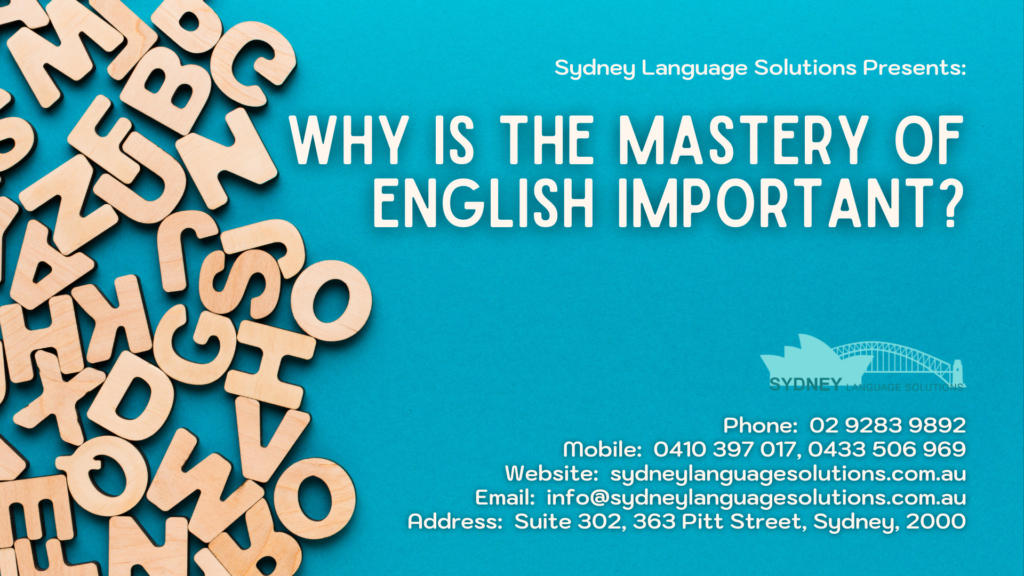Why is the Mastery of English Important?
Being the most commonly used language around the world, English is an essential skill for everyone – from students to professionals. This is particularly important in the workplace where you need to talk to clients, present your work to higher-ups, and communicate well with your colleagues.
If you want to be commended for your efforts and ensure that your point will be delivered across, you must have good communication skills and an excellent command of English. It will definitely boost your confidence if you are able to express yourself in a clear manner.
5 Tips on How to Reduce Your Accent to Sound Like a Native Speaker
Having an accent is not a bad thing; one should not be ashamed of it. A person’s accent represents his or her background and culture. Lots of people take pride in their accent as it reveals their cultural heritage. Even English native speakers have their own accents such as American-English, British-English or Australian-English. However, this sometimes causes difficulty in understanding so some people are embarrassed by their own accent in English Speaking. It turns out that having a residual accent might affect self-confidence in communication and interaction.
There are some techniques that non-native English speakers can use to reduce their accent in speaking.
- Slow down and clearly pronounce words
People tend to speak fast when they are excited or nervous. If you have an accent, try to speak slowly and clearly pronounce words so that everyone can understand what you want to say.
- Feel the rhythm while speaking English
English is considered “stressed language” as every single word have its own stress, differently on verbs, words and adjectives. Same to sentence. People said that sentence stress gives English a rhythm or beat.
- Listen and Talk to native speakers
Listen and repeat to sentences spoken by native speakers until you can naturally speak those sentences. Try to speak to the native speakers as many as possible. You need to overcome your in-confidence and speak to the native speakers. It might make you feel embarrassed at first but failure creates success. People also tend to imitate others whom they frequently interact with. Therefore, the more you talk to the native speakers, the more you could improve.
- Record yourself
Don’t learn from others only, learn from yourself. Take your time to record your speaking and listen again to identify your weaknesses. Recording will also make you proud of yourself in how clarity in your pronunciation has progressed.
- Take a class or tutor
Consider working with an experienced tutor or teacher to help you with pronunciation, intonation and even vocabulary. An ESL teacher will have his/her strategy to quickly help you with your accent. Joining a class might also motivate you as you have partners in your accent reduction journey.
English Pronunciation: Compound Adjectives
A compound adjective is a fixed expression which is made up of more than one word and which has the function of an adjective. Most compound adjectives are written with a hyphen, but a few are written as one word:
skin-deep long-term threadbare
The following types of compound adjective usually have main stress on the first part:
- compound adjectives usually written as one word
- ‘ airtight ‘ carefree ‘ praise , worthy
- Exceptions: , nation ‘ wide, , hand ‘ made
- noun + -ing form
- ‘ hair- , raising ‘ fee- , paying ‘ time-con,suming
- noun + past participle
- ‘ poverty- , stricken ‘ pear-shaped ‘ health-re,lated
- Exceptions: , eagle- ‘ eyed, , home- ‘ grown
The following types of compound adjective usually have main stress on the second part:
- noun + adjective
- , fat- ‘ free , sky- ‘ high , snow- ‘ white
- Exception: ‘ camera-shy
- adjective + noun
- , long – ‘ term , full – ‘ length , high – ‘ profile
- adverb or adjective + past participle
- , fully- ‘ grown , long- ‘ sighted , well – ‘ dressed
- adverb or adjective + -ing form
- , easy- ‘ going , hard – ‘ working , well – ‘ meaning
- Exceptions: ‘ backward – , look ing, ‘ forward- , looking
- self- as the first part
- , self- ‘ confident , self-in ‘ flicted , self- ‘ governing
Most compound adjectives with main stress on the second part can have stress shift. Compare:
- The tiger was fully-GROWN. but: It was a FULly-grown TIger.
- The prices were sky-HIGH. but: They were SKY-high PRIces.
5 Reasons Why Good English is Essential in Business!
English is the language of communication: English is the most widely spoken language in the world with over 1 billion people using it as a foreign language.
English spoken in business is different from English spoken in daily lives, as certain industries have certain vocabulary or jargon. For example, English vocabulary is different in business administration, finance, law or retail.
Mastery of English is beneficial even though you are working in your home country. Many businesses are international in scope and English is official language in the company.
Better job opportunities: if you work in English-speaking countries, English is a must. In non-English-speaking countries, it would be another skill that you can add to your resume and would boost your chances of job promotion.
More confidence in working: Business English with Sydney Language Solutions will improve your confidence in presentation, negotiation, conversation, better comprehension and pronunciation in Business context. All of these will boost your confidence in conducting Business in English.
ONE SIDE OR BOTH?
When it comes to IELTS argumentative essays, a very commonly asked question is “If they ask whether something is positive or negative, should I just pick one side? Is it okay to discuss both?” The answer is IT DEPENDS. It depends on 2 things: what the question actually is and what you can do better (not what you really think, yeah, not necessarily that).
To make it clearer, let’s look at the most typical questions one by one.
Question 1: Does this development have more positive or negative effects?
- The word MORE already implies that there are both positive and negative effects. Logically, we can only make comparison when there are at least two entities. Therefore, it is most reasonable to discuss both sides and make it clear with outweigh the other.
Question 2: Is it a positive or negative development?
- Imagine a real-life conversation. If your friend asks whether you think something is good or bad, what choices do you have? You can say it is terrible – you can’t stand it all; you can say it is awesome – you absolutely love it, OR you can say it is just so so – you enjoy part of it but at the same time find something unpleasant. There is nothing illogical or inappropriate about this. The same applies to IELTS essays. It is totally fine to either pick a side or discuss both, as long as you do not forget to point out which dominates.
And as always, choose what makes it easier for you to write. The examiner cares more about your writing skills than what you truly believe in, remember that!
DO NOT LOSE MARKS FOR TASK RESPONSE!
Among the 4 marking criteria for IELTS Writing Task 2, surprisingly, Task Response is where candidates are most likely to lose marks without being aware of it. The reason is they often focus on producing high quality language but in the end fail to FULLY ADDRESS the topic question.
Let’s look at some examples of rather “tricky” topic questions where candidates would easily fall into this Task Response trap.
Topic question 1:
Anybody can use a mobile phone to answer work and personal calls at any time for 7 days a week. Does this development have more positive or negative effects on both individual and society?
- For this topic, candidates who simply discuss the effects of “having a mobile phone” in general without limiting their discussion to its calling unction would be penalized. Mentioning details like “playing games” or “checking emails” would be considered off-topic and result in a lower score.
Topic question 2:
In today’s world of advanced science and technology, we still greatly value our artists such as musicians, painters, and writers. What can art tells us about life that science and technology cannot?
- If candidates only praise art but do not compare it with science and technology, they have not successfully covered all parts of the topic questions and of course would not receive good marks fort this criterion.
So, always read the topic question extremely carefully and make sure you understand what you are required to do!
IELTS: Five steps to write IELTS Task 2
How do you produce a decent piece of essay within 40 minutes or less to achieve your target band? Just follow the steps below:
Step 1: Understand the Question Type. (2 minutes)
Read the question (Is it Agree/Disagree, Advantage & Disadvantage, Problem & Solution, Discuss both issues + own opinion, Double Questions or Outweigh?)
Paraphrase the topic accordingly based on the question type and take your Position
Step 2: Brainstorming. (3 minutes)
Think of a few main points / specific reasons based on your taken position. Ask yourself if you can develop any 2 or maximum 3 of these into a full paragraph (of approx. 100 words). If no, discard the point/s; if yes, go ahead to step 3.
Step 3: Planning. (5 minutes)
Now use a mind mapping, flowcharting or tabling technique to expand th main points. What specific related details can I add to this? What example/s (from my experience, observation or knowledge) can I use?
Step 4: Writing. (25 minutes)
a. Introduction – (3 sentences of 30-40 words in total, consisting of Background General statement + expansion + Position / Thesis Statement).
b. 2-3 Body paragraphs – 1 sentence of Main Point, 2-3 detailed explanations, 1-2 example sentences AND 1 final Recap to relate back to your Main Point.\
c. Conclusion – 2 sentences of 20-30 words in total, summary / conclusion of your essay + a general reason / prediction / condition / position of the subject matter.
Step 5: Checking (5 minutes)
Proofread your essay for Grammar, Vocabulary, Spelling, Punctuation and Relevance / Consistency for the best result.
Keep practising till you get the hang of this!
26 August 2017
Telaga
Do you know that we have IELTS Band 7-8 Workshop and Essay Marking Services?
Visit Our Website: http://www.sydneylanguagesolutions.com.au/
Like Our Facebook: https://www.facebook.com/pages/Sydney-Language-Solutions/219610575890
Visit Our Bookstore: http://slsbooks.com.au/
If you have a good testimonial or pass our OET course, feel free to share your opinion at our OET Facebook Page : https://www.facebook.com/pages/Occupational-English-Test/265887706763949
Looking for a book? Check it on our facebook page:
https://www.facebook.com/pages/SLS-Books/1438776549712215?ref=hl
IELTS: Five Easy steps to plan to write Academic Task 1
How do you paragraph in this task? For many, this is very, very complicated. But it doesn’t always have to be like that. Just follow the steps below:
Step 1: Know how to plan Body Paragraphs
Take notes what to include in:
Body 1: Select main features / general trends (what do all these bars/lines/charts have in common?)
Body 2: Pick 2 differences/extremes and an exception (if any)
Step 2: Paraphrase the question in your first sentence of Introduction
Step 3: Add another sentence (overview / summary of Body 1+2)
This will tell the reader what to expect next, in the Body.
Step 4: If there is a relationship between two graphs, you can summarise the correlation in one sentence as your summary statement.
Step 5: In case of graph indicating past and future, the past can be your 1st body and the future can be your 2nd. If it is a diagram or process / flowchart, make sure you know the head and the tail, and divide the process into two separate categories, hence two body paragraphs.
Remember, if you have two sentences in Introduction, then a Conclusion is not mandatory.
24 July 2017
Telaga
IELTS: Scoring high in GT Task 1
Many students have the impression that they’ll score higher in GT writing than in Academic writing. Some score even lower in the former though. The reasons? They don’t know what kind of letter they should write. Here are things to know:
Depending on who the audience is, e.g. writing to your friend, teacher or neighbor or an organisation, you need to go through these steps:
- Decide on what register to use.
Informal, semi formal or formal?
2. Decide on how to use for salutation.
Hi Mike, Dear Mike, Dear Mr. Tyson, or Dear Sir or Madam?
3. Decide on the degree of formality.
Contractions? Conversational? Politeness? Directness? Respect?
4. Decide on how to organise the content.
Para 1: Introduction/Greeting + Purpose.
Para 2 & 3: Discuss Questions 1, 2 and 3 in sequence.
Para 4: Goodwill (remember degree of formality).
5. Decide on how to sign off.
This must be relevant to Step 2.
Informal: Best wishes / Cheers? Kind regards? Yours sincerely? Yours faithfully?
Lastly, remember to check your punctuation so you don’t end up losing marks! Good Luck!
24 June 2017
Telaga







Latest Comments